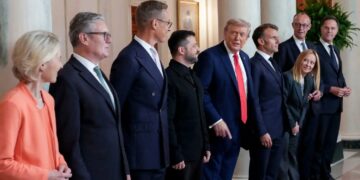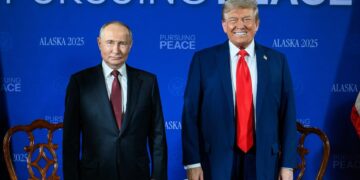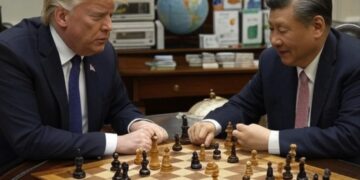In a dramatic finale to months of high-stakes negotiations, U.S. President Donald Trump and European Commission President Ursula von der Leyen announced a landmark trade framework on Sunday, July 27, 2025, at Trump’s Turnberry golf resort in Scotland. Hailed by Trump as “the biggest deal ever made,” the agreement averts a looming trade war between the United States and the European Union, the world’s largest trading partners, with a bilateral trade relationship valued at nearly $2 trillion annually. However, the deal’s lopsided terms have sparked mixed reactions, with European leaders expressing both relief and unease. Stakeholders Magazine delves into the details, implications, and stakeholder perspectives of this pivotal accord.
The Deal: Key Terms and Provisions
The framework establishes a 15% baseline tariff on most EU goods entering the U.S., including automobiles, pharmaceuticals, and semiconductors, a significant increase from the pre-2025 average of 1.2% but lower than Trump’s earlier threats of 30% or even 50% tariffs. Notably, the 15% rate replaces existing tariffs and is not additive, offering some relief to European exporters. Certain goods, including aircraft, plane parts, specific chemicals, generic drugs, semiconductor equipment, and select agricultural products, will face zero tariffs, fostering a “zero-for-zero” arrangement for these sectors.
The path to the agreement was fraught with tension. Trump’s “Liberation Day” tariff threats, announced on April 2, 2025, set a contentious tone, with the U.S. initially demanding tariffs as high as 50%. European negotiators, led by von der Leyen and EU Trade Commissioner Maroš Šefčovič, faced immense pressure to avoid a trade war that could have crippled global supply chains. Šefčovič described the negotiations as “very intense,” noting Trump’s initial insistence on a 30% tariff before settling on 15% after heated discussions.
The deal has elicited a spectrum of responses from stakeholders across the Atlantic, reflecting its complex implications.
The Trump administration celebrated the deal as a major victory, projecting $90 billion in tariff revenue based on 2024 trade figures and touting enhanced market access for U.S. farmers, manufacturers, and energy producers. The White House highlighted the deal’s potential to reduce the U.S. trade deficit with the EU, which stood at roughly €50 billion in 2024. Economists like Douglas Irwin of Dartmouth College expressed surprise at the EU’s concessions, noting that the agreement aligns closely with Trump’s demands. However, American consumers may bear the brunt of higher prices, as the 15% tariffs are likely to increase costs for EU goods like cars, electronics, and luxury products.
German Chancellor Friedrich Merz welcomed the deal, citing its role in averting a trade war that would have devastated Germany’s export-driven economy, particularly its automotive sector. However, he acknowledged “substantial damage” from the 15% tariffs, a jump from the previous 2.5% on cars. Italian Prime Minister Giorgia Meloni called the deal “positive” but reserved judgment pending further details, particularly on agricultural exemptions. Ireland’s Taoiseach Micheál Martin praised the agreement’s clarity but conceded that higher tariffs would make transatlantic trade “more challenging.”
European markets rallied, with the Stoxx Europe 600 index hitting a four-month high, up 0.68%, and Germany’s DAX and France’s CAC 40 rising 0.47% and 0.82%, respectively. The automotive sector, particularly German giants like Volkswagen and BMW, welcomed the reduction from a 25% U.S. tariff on cars to 15%. However, industries like French wine and spirits, which account for nearly half of Europe’s drinks exports to the U.S., face uncertainty as tariff exemptions remain under negotiation. The pharmaceutical sector secured a reprieve, with EU exports duty-free pending a U.S. investigation, though future tariffs are capped at 15%. Analysts at Société Générale and Capital Economics described the deal as “asymmetric,” predicting a 0.2% to 0.5% reduction in EU GDP due to higher tariffs. Italian winemakers, represented by Unione Italiana Vini, estimated a $371 million hit from the tariffs, underscoring the deal’s uneven impact.
The agreement marks a significant step in Trump’s mission to reshape global trade, following similar deals with Japan, the UK, Vietnam, and Indonesia. With trade talks looming with Canada, Mexico, and China, the EU deal sets a precedent for Trump’s aggressive tariff strategy. However, the deal’s focus on economic concessions over security concerns—such as Ukraine’s war with Russia or NATO’s defense commitments—has raised eyebrows. EU Trade Commissioner Šefčovič emphasized that the deal was about more than trade, citing its role in maintaining transatlantic unity amid global crises.
As the European Commission prepares to brief EU ambassadors and seek member state approval, the deal’s implementation faces hurdles. A “relatively light” joint statement is expected by Friday, followed by U.S. executive orders to enforce the 15% tariffs. The EU’s tariff adjustments, however, may take longer due to legal processes. Ongoing negotiations over wine, spirits, and steel suggest the framework is a starting point, not a final resolution.
The Trump-EU trade deal, forged in the shadow of a potential trade war, reflects a delicate balance of compromise and concession. While it stabilizes transatlantic trade, its asymmetric terms favor the U.S., leaving Europe to navigate a complex economic and political landscape. As details emerge and negotiations continue, Stakeholders Magazine will monitor how this “biggest deal ever” shapes the future of global trade and transatlantic relations.




























